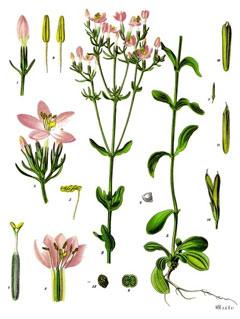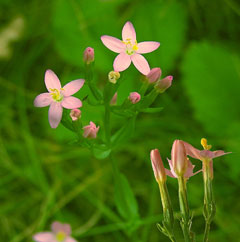 |
|
http://commons.wikimedia.org/wiki/File:Koeh-058.jpg |
 |
| http://commons.wikimedia.org/wiki/User:Teacoolish |
Translate this page:
Summary
Physical Characteristics

 Centaurium erythraea is a ANNUAL/BIENNIAL growing to 0.3 m (1ft) by 0.2 m (0ft 8in). It is in flower from June to October, and the seeds ripen from August to October. The species is hermaphrodite (has both male and female organs) and is pollinated by Bees, flies, beetles. The plant is self-fertile.
Centaurium erythraea is a ANNUAL/BIENNIAL growing to 0.3 m (1ft) by 0.2 m (0ft 8in). It is in flower from June to October, and the seeds ripen from August to October. The species is hermaphrodite (has both male and female organs) and is pollinated by Bees, flies, beetles. The plant is self-fertile.
Suitable for: light (sandy) and medium (loamy) soils, prefers well-drained soil and can grow in nutritionally poor soil. Suitable pH: mildly acid, neutral and basic (mildly alkaline) soils. It can grow in semi-shade (light woodland) or no shade. It prefers dry or moist soil.
UK Hardiness Map
US Hardiness Map
Synonyms
Centaurium minus. Centaurium umbellatum. Erythraea centaurium.
Plant Habitats
Woodland Garden Sunny Edge; Dappled Shade; Shady Edge; Meadow;
Edible Uses
Edible Parts:
Edible Uses: Condiment
The plant is used as a flavouring in bitter herbal liqueurs and is an ingredient of vermouth[268].
References More on Edible Uses
Medicinal Uses
Plants For A Future can not take any responsibility for any adverse effects from the use of plants. Always seek advice from a professional before using a plant medicinally.
Appetizer Aromatic Bach Bitter Cholagogue Diaphoretic Digestive Emetic
Febrifuge Hepatic Homeopathy Poultice Stomachic Tonic
One of the most useful bitter herbs, centaury strengthens digestive function, especially within the stomach[254]. By increasing stomach secretions it hastens the breakdown of food, it also stimulates the appetite and increases bile production[254]. The plant needs to be take over a number of weeks and an infusion should be slowly sipped so that the components (their bitterness can be detected at a dilution of 1:3,500) can stimulate reflex activity throughout the upper digestive tract[254]. The whole herb is appetizer, aromatic, bitter, cholagogue, diaphoretic, digestive, emetic, weakly febrifuge, hepatic, stomachic and tonic[9, 13, 21, 165, 268]. It acts on the liver and kidneys, purifies the blood and is an excellent tonic for the digestive system[4, 238]. Externally, the fresh green herb is said to be a good application to wounds and sores[4]. It is often used in combination with other herbs such as camomile (Chamaemelum nobile), meadowsweet (Filipendula ulmaria) and marshmallow (Althaea officinalis)[238]. The whole plant is harvested when in flower and can be dried for later use[4, 238]. The plant is used in Bach flower remedies - the keywords for prescribing it are 'Weak willed', 'Too easily influenced' and 'Willing servitors'[209]. A homeopathic remedy is made from the plant[9]. It is used in the treatment of liver and gall bladder ailments[9]. The German Commission E Monographs, a therapeutic guide to herbal medicine, approve Centaurium erythraea for dyspeptic complaints, loss of appetite (see [302] for critics of commission E).
References More on Medicinal Uses
The Bookshop: Edible Plant Books
Our Latest books on Perennial Plants For Food Forests and Permaculture Gardens in paperback or digital formats.

Edible Tropical Plants
Food Forest Plants for Hotter Conditions: 250+ Plants For Tropical Food Forests & Permaculture Gardens.
More

Edible Temperate Plants
Plants for Your Food Forest: 500 Plants for Temperate Food Forests & Permaculture Gardens.
More

More Books
PFAF have eight books available in paperback and digital formats. Browse the shop for more information.
Shop Now
Other Uses
Dye
A long-lasting bright yellowish-green dye is obtained from the flowers[13, 100].
Special Uses
Scented Plants
References More on Other Uses
Cultivation details
Prefers a well-drained sandy loam with some peat[1] and a sunny position[238]. It avoids wet or rich soils[115]. Plants are not easy to grow in a garden[4]. The flowers only open in fine weather and close at midday[4]. Although the growing plant is scentless, if the cut stems are immersed in warm water for 24 hours a most penetrating odour will be observed on distillation[245]. A very variable plant, some botanists divide it into a number of separate species[4].
References Carbon Farming Information and Carbon Sequestration Information
Temperature Converter
Type a value in the Celsius field to convert the value to Fahrenheit:
Fahrenheit:
The PFAF Bookshop
Plants For A Future have a number of books available in paperback and digital form. Book titles include Edible Plants, Edible Perennials, Edible Trees,Edible Shrubs, Woodland Gardening, and Temperate Food Forest Plants. Our new book is Food Forest Plants For Hotter Conditions (Tropical and Sub-Tropical).
Shop Now
Plant Propagation
Seed - sow February to May in situ or as soon as it is ripe in situ[17]. Germination is usually rapid.
Other Names
If available other names are mentioned here
Native Range
TEMPERATE ASIA: Afghanistan, Cyprus, Iran, Iraq, Israel, Jordan, Lebanon, Syria, Turkey, Russian Federation-Ciscaucasia (Ciscaucasia), Armenia, Azerbaijan, Georgia, Russian Federation (Dagestan), Russian Federation (Altay), Tajikistan, Turkmenistan, Uzbekistan TROPICAL ASIA: Pakistan EUROPE: Denmark, United Kingdom, Ireland, Sweden, Austria, Belgium, Switzerland, Czech Republic, Germany, Hungary, Netherlands, Poland, Slovakia, Belarus, Estonia, Lithuania, Latvia, Moldova, Ukraine (incl. Krym), Albania, Bulgaria, Greece (incl. Crete), Croatia, Italy (incl. Sardinia, Sicily), Malta, Romania, Serbia, Slovenia, Spain (incl. Baleares), France (incl. Corsica), Portugal AFRICA: Algeria, Libya, Morocco, Tunisia
Weed Potential
Right plant wrong place. We are currently updating this section.
Please note that a plant may be invasive in one area but may not in your area so it's worth checking.
Conservation Status
IUCN Red List of Threatened Plants Status :

Growth: S = slow M = medium F = fast. Soil: L = light (sandy) M = medium H = heavy (clay). pH: A = acid N = neutral B = basic (alkaline). Shade: F = full shade S = semi-shade N = no shade. Moisture: D = dry M = Moist We = wet Wa = water.
Now available:
Food Forest Plants for Mediterranean Conditions
350+ Perennial Plants For Mediterranean and Drier Food Forests and Permaculture Gardens.
[Paperback and eBook]
This is the third in Plants For A Future's series of plant guides for food forests tailored to
specific climate zones. Following volumes on temperate and tropical ecosystems, this book focuses
on species suited to Mediterranean conditions—regions with hot, dry summers and cool, wet winters,
often facing the added challenge of climate change.
Read More
Expert comment
Author
Rafn.
Botanical References
17
Links / References
For a list of references used on this page please go here
Readers comment
© 2010, Plants For A Future. Plants For A Future is a charitable company limited by guarantee, registered in England and Wales. Charity No. 1057719, Company No. 3204567.